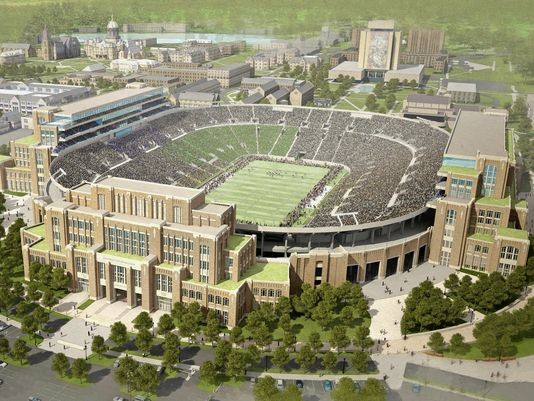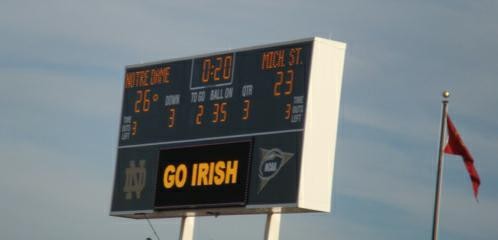University of Notre Dame Football Stadium
Introduction
Text-to-speech Audio
Images

Notre Dame's Scoreboard

Touchdown Jesus

Backstory and Context
Text-to-speech Audio
The University of Notre Dame is synonymous with tradition and football. The school was established in 1842 and has long been known for its football program. In 1930, coach Knute Rockne worked to move the team from Cartier Field to a much larger stadium that would rival those of other universities in an era when the largest programs were also building mammoth stadiums. Rockne also worked to develop a team that was worthy of the investment in a new stadium by winning games. Utilizing the same company that brought Comiskey Park and New York's Yankee Stadium and the Polo Grounds to life, Notre Dame built their stadium using the "Big House" at the University of Michigan as a model. When completed, the stadium cost $750,000 and could hold 59,075 fans.
Knute Rockne was only Notre Dame's coach for the first season of the new stadium due to a fatal plane crash in 1931. To honor the late coach, many of the details and practices that Rockne insisted upon were followed in later years. Rockne insisted that they keep the sod from Cartier field and that the surface would only be used for football. Rockne even implemented and supervised the parking system.
In 1997, the university added an additional 21,000 seats bringing the maximum capacity to over 80,000. This project cost over $50 million and included several renovations and new technology such as two new LED scoreboards, a new grass field, permanent lights, and a three-tier press box. Before this renovation, Notre Dame only hosted day games due to the lack of lights. Today, the university still holds only a few night games in accordance with tradition.
Sources
"Notre Dame Stadium." UND.COM. N.p., n.d. Web. 16 Feb. 2015. Notre Dame Athletics have historically been nationally known and credited accordingly. This site gives an overview to this history of Notre Dame's widely known stadium and the person who helped make it possible. Notre Dame's Official Athletic Site verified all the information, supplying the reader with credible facts and history. "History." // Notre Dame Stadium // Preserving the Traditions // University of Notre Dame. N.p., n.d. Web. 16 Feb. 2015. This source provides a brief background on the History of Notre Dame's nationally recognized stadium and its history. It is a part of the University's website and ensures credible information in that it is backed by the school itself.
